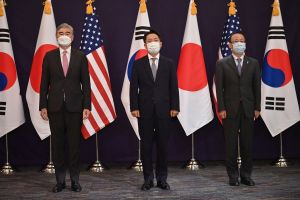American, Japanese, and South Korean publics see China as a more of a threat than a partner. Trilateral cooperation will be key to managing China's rise.
Against a backdrop of growing regional rivalry, March and April 2021 surveys conducted in the United States, Japan, and South Korea show that publics in all three countries share similar views of China’s growing influence and intentions. But the data also show that internal divisions within the US-Japan-South Korea relationship will pose challenges to deeper cooperation.1
Key Findings
- Greater than 80 percent in the United States, Japan, and South Korea say China intends to replace the United States as either the dominant power in the Asia-Pacific or as the dominant power in the world.
- But when placed in a broader context, neither China’s military power nor its economic power are considered as critical a threat as global or domestic challenges in any country. Moreover, denuclearizing North Korea and encouraging economic growth are seen as higher priorities for the alliances than is limiting China’s expansion in Asia.
- Despite strong economic ties with China, 6 in 10 in all three countries view China as more of an economic threat than a partner. And more than three-quarters say China is more of a security threat than a security partner.
- The South Korean and Japanese publics view the relationship between their own countries as more competitive than cooperative. In South Korea, 72 percent see Japan as a rival. In Japan, 80 percent say South Korea is a rival.
- But Koreans and the Japanese see potential areas of cooperation. Majorities in both countries support sharing intelligence on North Korea’s nuclear and missile programs (73% in Japan, 53% in South Korea) as well as cooperating on international development projects in Southeast Asia (58% in Japan, 62% in South Korea).
- 1
This work was made possible by the generous support of the Carnegie Corporation of New York, the Korea Foundation, and the Nakasone Peace Institute. It is part of a larger project focusing on US-Japan-South Korea cooperation.






